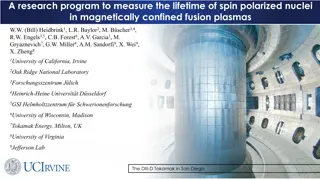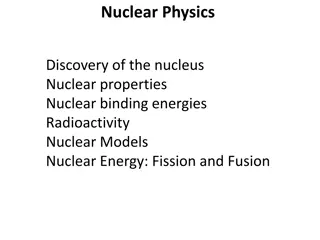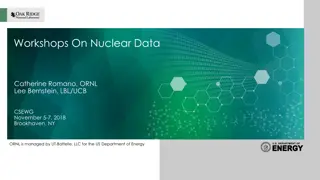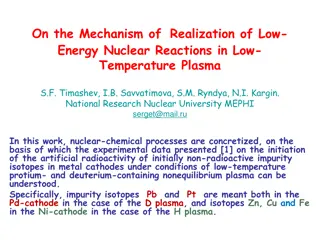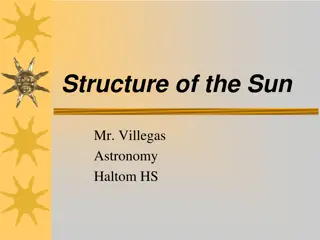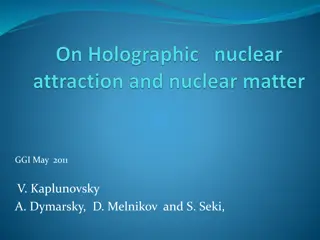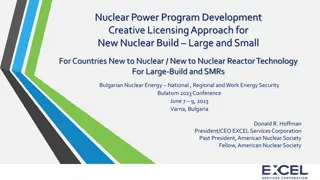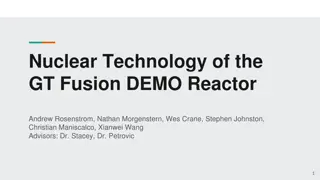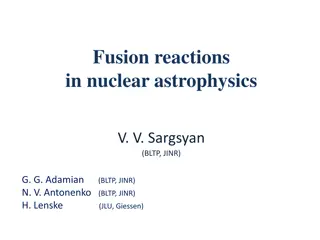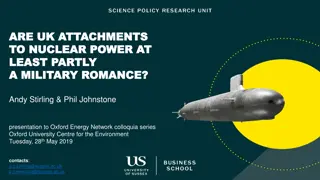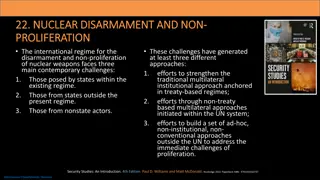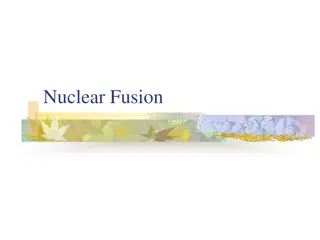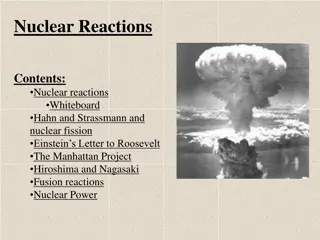
Unveiling Nuclear Fusion: A Journey of Energy Release and Potential
Nuclear fusion is the process of merging small atoms to release energy of immense potential. Discover the history, advancements, and future prospects of this fascinating phenomena that fuels the sun and drives scientific innovation.
Download Presentation

Please find below an Image/Link to download the presentation.
The content on the website is provided AS IS for your information and personal use only. It may not be sold, licensed, or shared on other websites without obtaining consent from the author. If you encounter any issues during the download, it is possible that the publisher has removed the file from their server.
You are allowed to download the files provided on this website for personal or commercial use, subject to the condition that they are used lawfully. All files are the property of their respective owners.
The content on the website is provided AS IS for your information and personal use only. It may not be sold, licensed, or shared on other websites without obtaining consent from the author.
E N D
Presentation Transcript
Nuclear Fusion BY IAN HULL
A brief overview and history.
What it is. Nuclear fusion is, at it s simplest, fusing two or more small atoms into a single atom of larger mass. This is accompanied by a massive release of energy, which is why it is a topic of great research, as this energy can be harvested to provide power. The amount of energy released during the reaction is dependent upon the fuel. A larger and more stable fuel is better than a small and unstable one. Nuclear fusion is also used as the driving force behind the massive explosion that occurs when a thermonuclear device is detonated.
Where it began. The history of nuclear fusion starts in 1920, Arthur Eddington, using F.W. Aston s measurements of the masses of low-mass elements and Einstein s famous E=mc2, proposes that large amounts of energy released by small nuclei fusing is what powers the sun.1 Then, in 1932, Mark Oliphant discovered helium-3 and tritium, tritium being extremely important as it is used in a fuel for terrestrial fusion reactions. He also discovered that heavy hydrogen nuclei react with each other.2
1950s 1950: The magnetic confinement fusion device was proposed by Andrei Sakharov and Igor Tamm. 1952: First detonation of a thermonuclear weapon, a bomb that uses fusion to produce the explosion. 1956: Soviet research and testing of systems takes place at Kurchtov Institute, Moscow.
1960s-2010s 1961: The Tsar Bomba is tested, a thermonuclear weapon with the largest yield ever made. 1968: The T-3 produces temperatures that are an order of magnitude higher than expected, resulting in optimism about the future of the systems. 1974: KMS Fusion carried out the world s first successful laser-induced fusion. 2014: Scientists at NIF in the U.S. achieved more energy from the reaction than had been put into the fuel, a huge breakthrough for fusion physics.
The meat and potatoes.
What is fusion really? As said before, fusion is two or more nuclei coming together to form a larger nucleus, with an accompanying release of energy. This does not happen randomly, however. The positively charged protons in each nuclei repel each other, due to their positive charges, as stated by Coulomb s Law. If the two nuclei are propelled into each other with sufficient enough force, the strong nuclear attraction is able to overcome the repulsion, and the two nuclei fuse into a heavier element.
Nuclear Binding Energy The nuclear binding energy is the energy needed to split an atom into the particle that it is made of, or inversely, the amount of energy released when two atoms fuse into a larger atom. The equation for calculating nuclear binding energy is: ? = ??2,(4)Where B is the binding energy, m is the mass, and c is the speed of light.
This is a curve of the binding energy for a select group of elements. All elements before Fe are fusion related, while all elements after Fe are fission related. Credit: Wikimedia Commons
Fusion Reactions. In most fusion reactions two nuclei (X1 and X2) merge to form a heavier nucleus (X3) and a lighter particle (X4). (4) The equation for a generic fusion reaction would be: ?1+ ?2 ?3+ ?4 An example of this format would be this equation for a Proton-Proton chain: 4H-1 He-4 + 2e++ 2 + 2 . e+is a positron, v is a neutrino, and is a photon.
Cross Section Of A Reaction. The cross section of a reaction(symbol ) is The number of reactions per target nucleus per unit time when the target is hit by one particle per target area per unit time.(4)
Reactivity. We can use the cross section( ) and the distance travelled during the amount of time(v) to calculate the reactivity of the target nuclei. The equation for it is simply < ?? >.(4)
Calculating The Fusion Energy Gain Factor. The fusion energy gain factor(Q) is a ratio of the power produced by the fusion to the power needed to keep the plasma in a stable state. 1 ? ??? ??????? ????? (1 ?? ), where: ? = nheat is the efficiency of the conversion of electrical power to the power needed to heat the plasma. frecirc is the fraction of power recirculated to run the reactor systems. nelec is the efficiency of the electricity produced in the plasma. fch is the fraction of the fusion power of charged objects still in the plasma.(5)
Stellar Nucleosynthesis
Nucleosynthesis. Nucleosynthesis simply means the production of nuclei heavier than hydrogen. This happens in our sun and other stars like it through two processes: The Proton-Proton chain, and the CNO(carbon, nitrogen, oxygen) cycle. Nuclear fusion only starts in the cores of stars when the density in the core is great and the temperature reaches about 10 million K. (3)
The Proton-Proton chain is the main process our sun uses to produce energy.(5) This reaction can be summerized as: 4H-1 He-4 + 2e++ 2 + 2 . Proton-Proton chain.(3)
The CNO cycle is a reaction that requires a C-12 nuclei to start the reaction, but can continue indefinitely after the initial catalyst. The CNO Cycle.(3)
Tokamak Reactors
What a Tokamak is. The Tokamak is a soviet designed device that uses electromagnetism to hold plasma in the shape of a torus. This proved to be impossible before the concept of the Tokamak came into existence, as a plasma placed into a purely toroidal magnetic field cannot come to an equilibrium force balance. The pressure of a toroidal plasma would cause it to expand and the toroidal magnetic field is unable to provide a balancing force. The result would be a very rapid loss of the whole plasma. (6)
The way the Tokamak design gets around the loss of plasma is by passing a toroidal current through the plasma itself, which causes a toroidal magnetic field line inside the plasma, along with poloidal field lines encircling the whole thing. This leads to a helical shape encompassing the plasma and making it stable. The toroidal current also provides an inward Lorentz force on the plasma.
Inertial Confinement
What Inertial Confinement Fusion is. Inertial Confinement Fusion is a type of laser-induced fusion where a small pellet made of the fusion fuel is bombarded on all side by lasers. The large pulse of energy causes the outer layer of the pellet to evaporate, and the particles leaving the surface cause a shockwave on the pellet. This shockwave compresses the pellet further and increases it s temperature to fusion ranges, which ignites the fusion reaction and the superheated plasma is formed. (7)
This is an example of the process that a pellet undergoes in Inertial Confinement Fusion. (Serway & Jewett "Nuclear Fusion" 2008)
Uses For Fusion In Science And Society.
Uses For Fusion In Science And Society. Fusion is useful to both science and society due to it being a cheap, clean, extremely powerful source of energy with abundant fuel. It is also useful to science as a potential propulsion system for deep space rockets.
Bibliography Note: All citations in this PowerPoint have a superscript number surrounded by parentheses. 1) Eddington, A. S. (n.d.). The internal constitution of the stars [Abstract]. The Observatory, 43, 341-358. Retrieved May 20, 2017, from http://articles.adsabs.harvard.edu/full/1920Obs....43..341E 2) "Mark Oliphant." Mark Oliphant - Engineering and Technology History Wiki. N.p., 4 Feb. 2016. Web. 20 May 2017. 3) "Main Sequence Stars." Main Sequence Stars. Australia Telescope National Facility, 07 July 2016. Web. 20 May 2017. 4) Atzeni, Stefano, and Ju rgen Meyer-Ten-Vehn. The physics of inertial fusion beam plasma interaction, hydrodynamics, hot dense matter. Oxford: Oxford U Press, 2009. Print.(This is a monograph and not a textbook) 5)"Fusion energy gain factor." Wikipedia. Wikimedia Foundation, 28 May 2017. Web. 20 May 2017. 6)Wesson, John. The Science of JET. N.p.: n.p., 2000. Print. 7) Serway, Raymond A., and John W. Jewett, Jr. "Nuclear Fusion." Physics for Scientists and Engineers with Modern Physics. 7th ed. N.p.: Thomson Learning Inc., 2008. 1335-342. Print. 8) Herrmann, Mark. "A Promising Advance in Nuclear Fusion." Nature 506.7488 (2014): 302- 3. ProQuest. Web. 2 June 2017.

